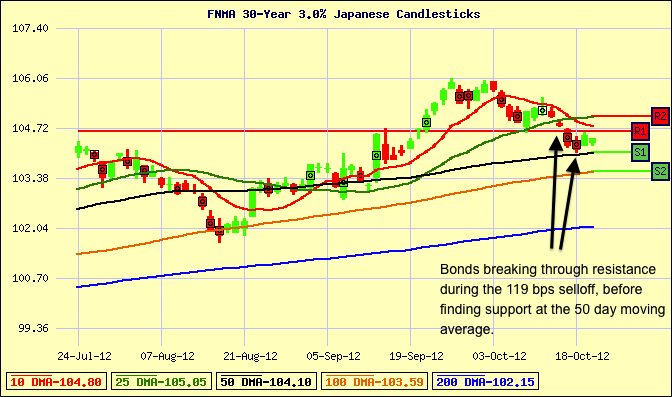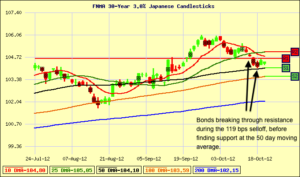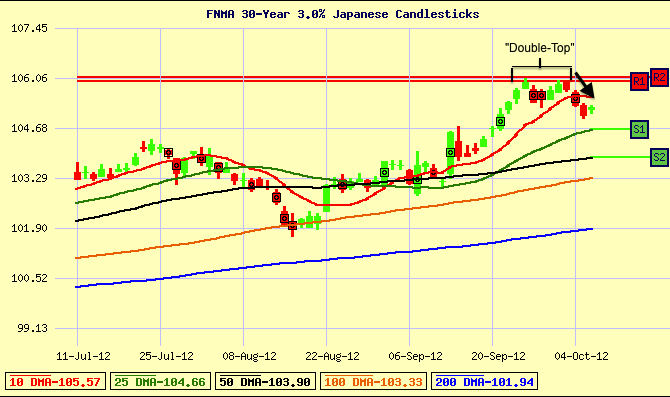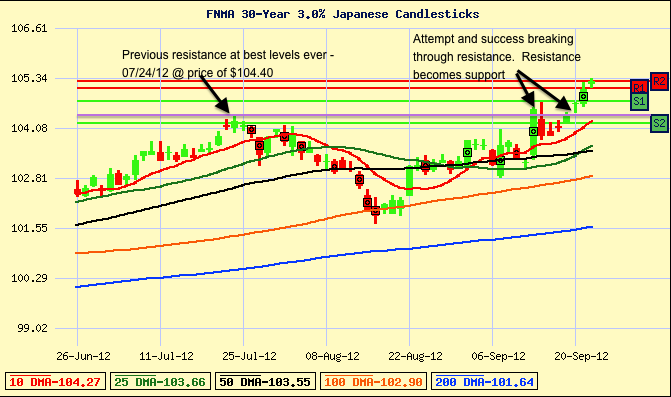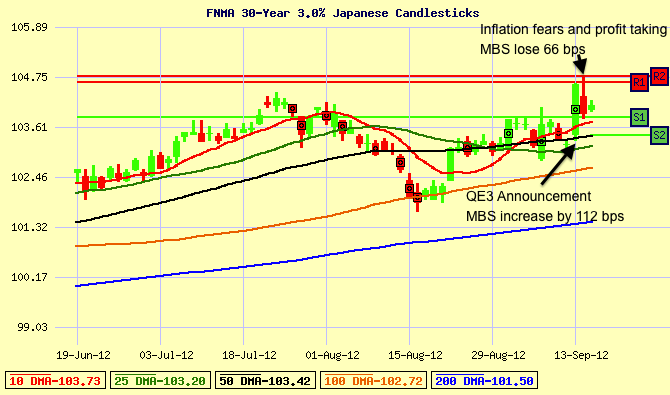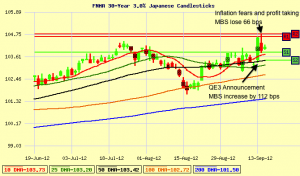Mortgage Rate and Real Estate Update – Week of 11/19/12
The ‘Fiscal Cliff’ looms into the holiday season, but we are thankful for what we have in front of us. A strong Texas housing market and interest rates lower than anyone could expect, we have many reason to give thanks…
Mortgage interest rate and real estate news from last week:
- Rising sales and lowest inventory in six years helps home prices rise 11.1 percent from a year ago
- Investors making record profits as single-family rental demand is causing rents to far exceed supply
- We’re fortunate to be closing refi’s in 30 days, while National Loan Processing Time Increases to 54 Days
- FHA hopes to avoid its own ‘fiscal cliff’ as expected budget shortage of $16.3 billion consumes their portfolio of insured home mortgages
Mortgage bonds have traded in a sideways pattern for the better part of a week as the markets await a resolution to congressional budgets and extensions to avoid a ‘fiscal cliff’. The metaphor of the cliff is pretty accurate for stocks and home loan rates, as a failure to reach a resolution could send stocks falling along with mortgage rates. However, as talks of a resolution start to surface and existing home sales were reported stronger than expected, we have seen stocks rally higher at the expense of Bonds and home loan rates.
What’s coming up this week on the economic calendar and what’s the impact on interest rates?
As the President and lawmakers try to iron out details surrounding the congressional budget, the main focuses are to avoid tax increases and spending cuts that would likely send the U.S. economy into a recession. Progress will be halted until Congress resumes their session on November 26th, so stocks and Bonds are likely to stay calm during this Thanksgiving week.
On the economic calendar, New Housing Starts and Building Permits will be released tomorrow to finish out the housing reports for the week. Initial Jobless Claims will be released on Wednesday. With the stock and Bond markets closed on Thursday and both markets closing early on Friday, we don’t expect much volatility throughout the week.
Here’s our strategy for the days and weeks ahead…
Home loan rates continue to trade in a tight range and are holding above support at the 25 day moving average. With little news expected and no treasury auctions this week, mortgage rates should manage to hold onto their near historic lows. With the ‘Fiscal Cliff’ looming, we will be monitoring the newswires closely. Any talks of an agreement will send stocks higher and will likely send home loan interest rates higher.
We maintain an ongoing dialogue with our clients about the market and interest rates throughout their financing experience so we can take advantage of the lowest rates when they present themselves. We all want the lowest rate, and the best way to ensure that you get the lowest rate, is to build a relationship with your mortgage planner, so they can best advise you on when to lock in your rate. Call us today for a complimentary mortgage review or Apply Online.
Mortgage Rate and Real Estate Update – Week of 11/13/12
Stocks fall helping mortgage rates remain low after election results. Mortgage bonds sit on an important level and will help send rates up or down. Find out which direction interest rates are heading.
Mortgage interest rate and real estate news from last week:
- On Veteran’s Day, HUD Honor’s Veteran’s Service by reinforcing the benefits ans services available to those who have sacrificed for our country
- With the housing market picking up and interest rates at historic lows, find out why Longer Approval Times Will Cost You
- Selling a home needs a strategy, ask for referrals to a real estate agent and avoid 4 Obstacles in the Way of Selling Your Home
- Sad but true for a lot of transactional loan officers out there. 9 Places You Won’t Find Your Loan Officer
The bond markets and mortgage backed securities took the results of the Presidential election as a sign that further spending and stimulus could be in store until the economy makes a noticeable recovery. Bond prices saw an immediate surge on Wednesday while stocks suffered. As mortgage bond pricing reached resistance set back on October 12th, the bonds quickly reversed course and sent home loan rates back to the levels from previous weeks. The short-term yet steep move in mortgage pricing is a perfect example of the window of opportunity that we look for to lock in a client’s interest rate.
What’s coming up this week on the economic calendar and what’s the impact on interest rates?
With the Bond markets closed on Monday in observance of Veterans Day, Stocks and Bonds have both opened the week to the downside. Driven in part by continued bad news out of China and now fears of investor confidence in Germany, the S&P 500 has closed once again below its 200-Day moving average, a previous stronghold for investors. If the S&P continues to drop below this level, we expect that bonds and mortgage backed securities would benefit from further stock selling as their money flows into the safe-haven of bonds.
The economic news for the week will be highlighted by the Wednesday release of Retail Sales and the Thursday release of Core Consumer Price Index (CPI), a popular measure of inflation. Now that the QE3 stimulus spending has had a chance to make an appearance in the markets, it will be interesting to see if inflation can continue to remain in check and within the Fed’s target range. Remember that any news of rising inflation will likely have a direct impact on home loan rates going up.
Here’s our strategy for the days and weeks ahead…
Mortgage bonds continue to hold on to support at the 25 day moving average and slightly above the 50 day moving average. These two levels of support should help keep interest rates from going much higher than their current levels. With that in mind, we will be recommending our clients float their interest rate as we wait for the economic reports this week. Longer term we are cautiously optimistic that interest rates could make a run at the historic levels reach last month, but will remain vigilant and take advantage of opportunities as interest rate see their short-term drops.
We maintain an ongoing dialogue with our clients about the market and interest rates throughout their financing experience so we can take advantage of the lowest rates when they present themselves. We all want the lowest rate, and the best way to ensure that you get the lowest rate, is to build a relationship with your mortgage planner, so they can best advise you on when to lock in your rate. Call us today for a complimentary mortgage review or Apply Online.
Mortgage Rate and Real Estate Update – Week of 11/5/12
The election looms in the wake of Hurricane Sandy, but what’s the impact on real estate and home loan rates? Is the Fed creating a housing bubble – on purpose? The President, mortgage rates, and what would happen in the event of an electoral college tie?
Mortgage interest rate and real estate news from last week:
- Market closes two consecutive storms in wake of Hurricane Sandy. This was the first two-day close in the market since 1888
- Single family housing starts up 43% from 2011. Dallas area home prices increase by 3.6% from July to August
- Home remodeling hits highest point since Q3 of 2005, showing “owners become more confident that investments in housing will hold their value”
- How do Zillow and Trulia compare to an IDX search site?
- Jobs Report released on Friday 11/2 shows 171,000 new jobs created. Great news for the economy and typically bad news for mortgage bonds, the Fed and QE3 helped keep mortgage prices from taking a hit.
- An Electoral College tie – and what it would mean
- Is the Fed creating a housing bubble with its Quantitative Easing – on purpose?
Mortgage backed securities were able to respond positively last week after bouncing off support at the 50 day moving average. This support and market rally shows a new trend that could help bring interest rates to test the lowest levels in history. While the MBS still sit 100 basis points below best levels, most major resistance has been broken and could help home loan rates improve.
What’s coming up this week on the economic calendar and what’s the impact on interest rates?
After the impact of Hurricane Sandy, much of the Northeast is still recovering and waiting for power to be restored. Between the storm recovery efforts and the Presidential election on Tuesday, the markets may be quiet in anticipation of our next Commander-in-Chief. Regardless of who is elected, the global markets are filled with uncertainty not only from the election but also with continued fears of Greece collapse.
The results of the election may not play a large role in the short-term direction of home loan rates. Interest rates are likely to only be impacted in the event that the new President is able to stimulate the economy. When the economy and employment rates are thriving, households are able to spend more and Banks are more likely to lend. As a result, home loan rates and interest rates as a whole will go up. If the elected President is not able to initiate an economic recovery, the monetary policy strategy will continue to target keeping rates low for Banks and individuals, an effort to stimulate borrowing and spending to get things back on track. Regardless of the Presidential nomination, a path to economic recovery will be accompanied by a rise in interest rates.
Here’s our strategy for the days and weeks ahead…
Home loan rates have managed to fall back to near historic lows after the rally in mortgage backed securities last week. Since MBS rebounded at the 50 day moving average and have managed to climb above the 25 day moving average, these areas will now act as a level of support. Bond prices should attempt to reach historic lows once again. In the short-term, we are advising that our clients float their interest rate with the hope the pricing can continue to improve and bring home loan rates lower. With the election as a potential catalyst, any sell-off in MBS that causes a drop below the 25 day moving average, we will quickly switching our stance to lock in rates in the short-term.
We maintain an ongoing dialogue with our clients about the market and interest rates throughout their financing experience so we can take advantage of the lowest rates when they present themselves. We all want the lowest rate, and the best way to ensure that you get the lowest rate, is to build a relationship with your mortgage planner, so they can best advise you on when to lock in your rate. Call us today for a complimentary mortgage review or Apply Online.
Mortgage Rate and Real Estate Update – Week of 10/29/12
NYSE closed and Bond Markets closing early with Hurricane Sandy bearing down on the Northeast. Zillow launches its “Foreclosure Center” for prospective home buyers.
Mortgage interest rate and real estate news from last week:
- Zillow reports that U.S. home values saw their largest gain since 2006 with values jumping 1.3 percent in the third quarter
- Zillow launches its “Foreclosure Center” to give prospective home buyers access to pre-foreclosures, foreclosures and auctions in their area – http://www.zillow.com/foreclosures/
- Fed policy statement hints of continued slow growth with QE3 bond buying until the U.S. economy can support itself
- Third quarter GDP grew compared to the second quarter. Increased home buying helped fuel the growth
- Japan launches stimulus of $9.4 billion to increase growth and avoid “the risk of a Japanese fiscal cliff”
- Bank of America’s $4 billion purchase of Countrywide costs B of A more than $40 billion after write-downs, legal expenses, and settlements
What’s coming up this week on the economic calendar and what’s the impact on interest rates?
With the Bond Markets closing early on Monday in the wake of Hurricane Sandy, prices of mortgage backed securities opened higher but light trading is expected until the storm passes. SIFMA, who oversees the Bond markets, has announced that Bond markets will also be closed on Tuesday.
Core PCE was released upon market opening on Monday and showed a slight increase, a signal that inflation is starting to creep into the picture. However, the Fed still maintains a stance that inflation is not a concern. Halloween on Wednesday could prove to be a spooky trading day as investors hope to be back in action after a weather induced trading hiatus.
Weighing heavy on their trading direction will be the ADP Employment Report, Employment Cost Index and Chicago PMI, all scheduled for release on Wednesday morning. The reports continue on Thursday with Initial Jobless Claims and the national manufacturing index, ISM. ISM measures expansion or contraction in national manufacturing with a number over 50 signaling expansion and a number below 50 signaling contraction. The week closes with the Friday morning release of a highly anticipated Jobs Report. Having shown signs of growth and lower unemployment, more of the same is expected for the last Jobs Report before the election.
Here’s our strategy for the days and weeks ahead…
Bond prices and home loan rates won’t see much activity over the coming days, but we will be on guard when the markets reopen on Wednesday. With a heavy dose of Bond impacting news and shorter window to accomplish their Bond purchasing for the week, we could see home loan rates make an attempt to get back to their best levels ever. We will be watching the market reports closely throughout the week. Should pricing fall below current levels of support, we will recommend locking.
We maintain an ongoing dialogue with our clients about the market and interest rates throughout their financing experience so we can take advantage of the lowest rates when they present themselves. We all want the lowest rate, and the best way to ensure that you get the lowest rate, is to build a relationship with your mortgage planner, so they can best advise you on when to lock in your rate. Call us today for a complimentary mortgage review or Apply Online.
Current Mortgage Interest Rates – Week of 10/22/12
Mortgage interest rates increase by a quarter percent with selling pressure proving to be too much for Fed’s QE3 purchasing power. Nearly $100 billion in Treasury auctions, 3rd quarter GDP, and a FOMC meeting likely to make an impact on rates going forward.
What happened with mortgage interest rates last week?
Mortgage backed securities had one of their worst trading weeks in over 2 months, losing nearly 120 basis points before seeing a slight rebound on Friday. The selling pressure pushed mortgage bonds beneath support before finding resistance at the 50 day moving average. The move caused interest rates to increase by nearly .25%, providing another glimpseof how selling pressure can outweigh the Fed’s QE3 buying power.
The bond selling was largely influenced by economic releases and market news that began after the major inflation reading, Core CPI, was reported higher than expected. Not so great news for the first major inflation reading following the launch of QE3. Additionally, housing starts in September increased by 15% and Moody’s reported that they would maintain Spains debt rating. Positive economic news and higher than expected inflation is a recipe for Stock buying and Bond selling.
Further selling pressures are coming from an influx of new mortgage originations. As the low rates continue to increase home purchase loan and refinance activity, the added volume will continue to test the Fed’s QE3 purchasing power for months to come.
What’s coming up this week on the economic calendar and what’s the impact on interest rates?
The economic calendar is light this week with no major economic reports due other than a reading on third quarter Gross Domestic Product (GDP) on Friday. The biggest news of the week will come with the Fed’s monetary policy statement on Wednesday at 11:30 am CT. The statement will follow the two-day Federal Open Market Committee (FOMC) meeting. While there are no major changes expected to the Fed Funds Rate or the QE3 mortgage backed security purchase program of $40 billion per month, traders and investors will be analyzing the statement line by line to make notice of any changes.
Also on the radar this week will be the Treasury auction of $99 billion in two, five, and seven year Treasury notes. The added supply will give more options to investors and could sway purchasers away from mortgage Bonds until they establish further support on the 50 day moving average.
Here’s our strategy for the days and weeks ahead…
Following the large sell off in mortgage backed securities, Mortgage Bonds should technically hold on to current support at the 50 day moving average. For clients that were not able to lock in their rate last week before the market moved, we are recommending they float into the FOMC meeting, anticipating that pricing can rebound after being oversold. Should the market start to push Bonds below support, we will immediately shift to a Locking stance. The next level of support is over 100 basis points lower and would translate to higher interest rates.
We maintain an ongoing dialogue with our clients about the market and interest rates throughout their financing experience so we can take advantage of the lowest rates when they present themselves. We all want the lowest rate, and the best way to ensure that you get the lowest rate, is to build a relationship with your mortgage planner, so they can best advise you on when to lock in your rate. Call us today for a complimentary mortgage review or Apply Online.
Current Mortgage Interest Rates – Week of 10/15/12
Home loan rates stabilize in a new trading range after a 4 day sell off. Despite tame inflation and QE3 Bond buying, interest rates fail to recover back to historic lows. With a new trading trend emerging and a full week of economic releases, find out why you may need to lock in your interest rate before Friday.
What happened with mortgage interest rates last week?
Mortgage backed securities end the week roughly where it started, failing to break through resistance and re-establish a trading territory at the best levels for mortgage rates. After opening the week lower and dropping for the 4th day in a row, mortgage bonds found support at the 25 day moving average.
Weekly Initial Jobless Claims were reported at their lowest level since 2008. This encouraging news came after a report earlier this month that showed the Unemployment Rate dropped to its lowest level since early 2009. Both reports show promise for employment, but may be a brief blip on the radar amongst a trend of otherwise stagnant growth.
The Mortgage Bonds continued to trend higher on Friday morning after the Core PPI came in within the Fed’s target range. Core PPI is a wholesale inflation reading that will act as a barometer for the Fed and their ability continue stimulus and maintain a low rate environment.
It’s worth noting that Bonds have run out of steam the last 3 Fridays, causing rates to see a brief move higher. With the Fed only purchasing a set amount of Bonds per week, once those allotted funds are gone, the Bond trading will be handled without interference in the open market. When that’s happened to this point, Bonds have suffered.
What’s coming up this week on the economic calendar and what’s the impact on interest rates?
The economic calendar this week is packed with important data that could have an impact on Stocks and Bonds. The inflation readings will start with tomorrow’s (10/16) release of the Consumer Price Index (CPI). While the Core PPI released last week was tame, the CPI will be the first major inflation gauge since the Fed started into their QE3 printing/spending.
The economic reports continue on Wednesday with a projected increase in housing starts and building permits. While the reading may not have a large impact on Bond prices, the reports are worth noting as we move further into the week. Thursday will feature the release of more labor data with Initial Jobless Claims at 7:30 CT. Most attention from bond traders will be placed on the Philly Fed Index at 9am CT. The manufacturing report can have an impact on Stocks and Bonds as it helps forecast the upcoming release of the ISM Index.
Here’s our strategy for the days and weeks ahead…
With Bonds trading near support at the 25 day moving average, we are recommending our clients carefully float the market. The support can help provide a worst-case-scenario with an opportunity to lock in the rate if pricing breaks through the resistance level. However, Bonds are still trading near historic lows and the Fed has yet to show that their QE3 purchasing power has the ability to drive rates much lower. Given that rates have suffered at the end of the last 3 weeks, our sentiment may shift towards a locking bias if Bonds fail to make any substantial move in our favor.
We maintain an ongoing dialogue with our clients about the market and interest rates throughout their financing experience so we can take advantage of the lowest rates when they present themselves. We all want the lowest rate, and the best way to ensure that you get the lowest rate, is to build a relationship with your mortgage planner, so they can best advise you on when to lock in your rate. Call us today for a complimentary mortgage review or Apply Online.
Current Mortgage Interest Rates – Week of 10/9/12
Mortgage bonds reach their peak for a second straight week but fail to set new records. PIMCO bond fund manager and co-founder warns bonds could be “burned to a crisp”.
What happened with interest rates last week?
Mortgage bonds peaked at the best levels in history for the second straight week, signaling a new ceiling of resistance for bonds, with investors less willing to buy at historic levels. With mortgage interest rates still at or near historic lows, the Fed is accomplishing its goal of keeping rates low through the QE3 bond buying.
The economic news was light last week, leading up to Friday’s Jobs Report, where the Labor Department reported 114,000 new jobs in September and a falling Unemployment Rate of 7.8%. Both figures showed signs that the labor market is starting to see some level of improvement.
Positive headlines out of Europe led to investor selling pressures earlier in the week, but the Fed quickly stepped in to purchase the added supply. Further selling pressure came as Bill Gross, the manager of the world’s biggest bond fund with over $1.8 trillion in assets under management, warned that bonds could be “burned to a crisp” if the U.S. doesn’t tackle its debt problems. He further warns that if the U.S. does not change its fiscal direction, we jeopardize the U.S. Treasury and mortgage bonds’ status as the world’s go-to safe haven, in addition to the dollar’s role as the world’s premier reserve currency. This says a lot from a guy whose fund made $2.8 billion in cash last month from their Bond activity.
What’s coming up this week on the economic calendar and what’s the impact on interest rates?
The market was closed on Monday in observance of Columbus Day. Bond prices opened the week higher on Tuesday, following a report from the International Monetary Fund (IMF), stating that the world economy will grow by 3.3% this year, the slowest since 2009. News that’s bad for economic growth, but good for safe-haven bond buying and interest rates.
On the economic calendar, the activity will be light until Thursday at 9:30 CT when Initial Jobless Claims are released. Although the release shouldn’t have a big impact on mortgage interest rates, we will watch closely to gauge any growth in the employment sector. Also weighing on Bonds this week will be a $32 Billion 3-Year Note auction on Tuesday 10/9.
Having peaked at the same resistance levels and pulled back each of th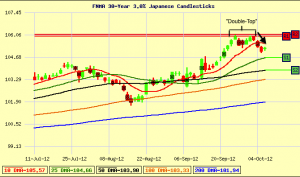 e last two weeks. From a technical standpoint, a “Double Top” has formed, signaling a short-term bearish signal. This technical signal appears when mortgage bonds have a rise, a drop, another rise of the same level, and another drop. Instead of breaking through the ceiling of resistance, the Bonds have been pushed lower at the resistance each time. After multiple attempts, odds are not good that the level will be broken in the near term.
e last two weeks. From a technical standpoint, a “Double Top” has formed, signaling a short-term bearish signal. This technical signal appears when mortgage bonds have a rise, a drop, another rise of the same level, and another drop. Instead of breaking through the ceiling of resistance, the Bonds have been pushed lower at the resistance each time. After multiple attempts, odds are not good that the level will be broken in the near term.
Here’s our strategy for the days and weeks ahead…
Having attempted to break through and set new historic lows, mortgage backed securities have seen pretty steep sell-off since the end of last week. While we do expect interest rates to maintain their current trading range, I feel that the opportunity to buy a new home or refinance your current home at the lowest rates in history will not be around for long. That could be weeks, could be months, but the opportunity will not be around for years. If you’ve thought about selling and buying a home, it’s time to create a game plan.
The Fed will continue its Bond buying through QE3, maybe even a QE4, 5, 6…. But, we tend to agree with Mr. Gross and his PIMCO billions. The man understands the Bond market and has brought up a valid point that ties together our fiscal direction and the value of our U.S. Bonds and Dollars. As a “safe-haven” for the fearful global investor, we don’t realize how their safety-seeking investing has helped keep our markets afloat with their influx of capital. If the sentiment ever turns to our Dollar and Bonds not being a “safe-haven”, we could see bonds, rates, and our dollar suffer greatly.
Our clients that we have closing in the near term are advised to float their interest rate to see if Bonds can make another run at their historic levels. After a several week, upward trend, we will be switching our stance to a locking bias if selling pressures cause Bond prices to suffer. Longer term transactions occurring in the next few weeks to months, we recommend starting your approval process now to be in a position to lock in your rate when the opportunity arises.
We maintain an ongoing dialogue with our clients about the market and interest rates throughout their financing experience so we can take advantage of the lowest rates when they present themselves. We all want the lowest rate, and the best way to ensure that you get the lowest rate, is to build a relationship with your mortgage planner, so they can best advise you on when to lock in your rate. Call us today for a complimentary mortgage review or Apply Online.
Current Interest Rates – Week of 10/1/12
Stocks suffer their worst weekly loss in over a year. Home loan interest rates reach their lowest levels ever, but where can they go from here?
What happened with interest rates last week?
The stock market finally ran out of steam last week as the worst weekly loss since last June was handed to investors. Fortunately for home buyers and someone thinking about refinancing, as stocks are sold, investors will often shift their money to mortgage bonds and drive our mortgage rates lower.
Mortgage backed securities put on quite a show as they rocketed to new historic highs as the expense of the stock sell-off. The rally did fizzle as the week came to an end. In part due to a research report from Nomura Research, indicating that now is a time to take profits in Mortgage Bonds and adopt a more neutral stance. If this advise is followed, the mortgage bonds will lose in price with the investor profit-taking, driving home loan rates higher.
The disconnect between the state of our economy and stock prices has continued to grow. In large part due to a varying difference in philosophies between our government and business owners. Many major corporations have spent the last few years cutting back expenses in an attempt to sustain during the times of recession and economic uncertainty. The fears of slowing growth and lack of conviction in a political direction have made companies reluctant to grow and hire new employees. The end result is companies effectively managing their cash flow and creating a surplus of cash, allowing the payment of dividends and the hope of minimized downside risk. On the other hand, our economy and government as a whole (both parties), are continuing in a direction of increased spending through economic stimulus, and employment growth through government jobs. The end result here is yet to be seen, but the deficit continues to climb and massive amounts of cash only seem to appear in the form of stimulus. Which philosophy do you think is working?
What’s coming up this week on the economic calendar and what’s the impact on interest rates?
The economic calendar is light this week leading up to the Non-farm payrolls report on Friday. The majority of pressure on mortgage bonds and home loan rates will stem from reactions to Fed news and commentary throughout the week. Wednesday will feature the release of the FOMC Minutes. We already know that QE3 was the main topic in the last meeting, but the minutes could highlight some key points and opinions from the Fed members. Particularly after Charles Plosser, President of the Federal Reserve Bank of Philadelphia, said he doesn’t think that QE3 will be effective and that competing philosophies are dividing the Fed members.
Investors in stocks and bond markets will also be monitoring political unrest in Europe as Spain and Greece digest new austerity measures that may spawn violent protests. Any unrest could be a catalyst for investors to seek the safe haven of our bonds.
Here’s our strategy for the days and weeks ahead…
With mortgage backed securities sitting at the best levels in history and mortgage interest rates extremely low, the Fed is achieving their goal. There’s little reason to think that home loan rates will move significantly lower.
In the near term, we would expect that home loan rates would trend higher before going lower. The Fed has their stimulus spending gun loaded to keep rates low, but as we started to see late last week, when supply starts hitting the market (bond sellers), there has to be a buyer on the other end (Fed) to keep the price from deteriorating. Once the supply outweighs the purchasing power, the bond prices will drop and rates will go up. To protect against this, we continue to recommend locking in rates at historic lows.
We maintain an ongoing dialogue with our clients about the market and interest rates throughout their financing experience so we can take advantage of the lowest rates when they present themselves. We all want the lowest rate, and the best way to ensure that you get the lowest rate, is to build a relationship with your mortgage planner, so they can best advise you on when to lock in your rate. Call us today for a complimentary mortgage review or Apply Online.
Current Interest Rates – Week of 9/24/12
Mortgage backed securities continue to paint the record books with the help of QE3 and the Fed’s attempt to further stimulate the economy. Find out why Robert Shiller from the Case/Shiller Home Price Index says that he feels that mortgage interest rates will not fall much further from their current levels. Is this the best rates are going to get?
What happened with interest rates last week?
Home loan interest rates managed to find their way back to all time lows last week as the Bond markets started their rally based on weak economic data out of Asia and Europe and the continued Bond buying from the Fed and the QE3 stimulus. The Fed is currently purchasing $40 billion of mortgage backed securities each month and could not have ho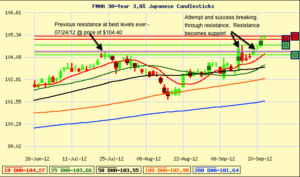 ped for better results in the first full week of the stimulus. Mortgage backed securities have risen by over 125 basis points, leading to our lowest interest rates ever. Aside from the weak economic data out of Asia and Europe, Initial Jobless Claims came in higher than expected at a number of 382,000.
ped for better results in the first full week of the stimulus. Mortgage backed securities have risen by over 125 basis points, leading to our lowest interest rates ever. Aside from the weak economic data out of Asia and Europe, Initial Jobless Claims came in higher than expected at a number of 382,000.
From a technical standpoint, we’re painting a new picture going forward. Mortgage backed securities have broken through all previous resistance levels established back on July 24th, 2012, our previous all time highs. As a result of breaking through resistance, these levels now will act as a floor of support, highlighting a new “worst case” pricing for home loans closing in the near term.
What’s coming up this week on the economic calendar and what’s the impact on interest rates?
The economic calendar is packed with releases this week. Starting on Tuesday with the Case-Shiller Home Price Index and Consumer Confidence, New Home Sales on Wednesday and Initial Jobless Claims on Thursday, the markets should continue their current trend leading into the big news on Friday. The Friday reports will start off with the Core Personal Consumption Expenditures, the Fed’s favorite gauge of inflation, which measures price changes in consumer goods and services after excluding food and energy components. Since inflation has a direct impact on interest rates, the report will be monitored to see if the year-over-year inflation figure has increased from its previous level of 1.6%. Also schedule for release on Friday is the Chicago PMI. Also known as the “Business Barometer”, the Chicago PMI is a manufacturing report indicating what may be to come in the ISM survey that will be released the following business day.
Here’s our strategy for the days and weeks ahead…
The stage is set for home loan rates to drop to the lowest levels we may see in our lifetime. Mortgage backed securities have broken through nearly all resistance levels, weak economic news continues to flow out of Europe and Asia, QE3 is in full swing. What more could we ask for?
Robert Schiller of the Case-Schiller Home Index expects that mortgage rates will not fall much further from their current levels. Here are a few reasons why:
- High Loan Volume = Higher Rates – The home purchase markets are continuing to gain traction as home prices stabilize and interest rates set historic lows. Throw in the numerous refinance programs available to current home owners and you’ll find lenders across the board are as busy as they have been in years. When loan volume increases and lenders start to reach capacity, they reach a breaking point. Beware of the bigger Banks like Wells Fargo, Chase, Bank of America, Citi, etc. Turn times are likely to get extended to a point that the applications are not able to close for 60-90+ days. As a result, their interest rates may be adjusted higher to slow down incoming applications. Smaller Banks and lending institutions (ie. Brazos National Bank) can avoid some of these issues with streamlined underwriting and closing processes.
- “G-Fee” – The “g-fee” or Guarantee fee has been implemented twice in the past 12 months and is a charge on all Fannie Mae and Freddie Mac home loans. The fee equates to roughly 75 basis points in price adjustment and is designed to raise revenues for Fannie/Freddie in an attempt to privatize the government sponsored entities. The previous “g-fee” was announced less than 3 weeks ago, and is now being followed by a third round of “g-fees”, targeting New York, Florida, Connecticut, New Jersey and Illinois. Follow the link to read FHFAs notice.
As the Guarantee fees mandated by FHFA continue to accrue and big Banks run at max capacity, the QE3 stimulus can only do so much to drive down home loan rates. A disconnect will start to form between the price of mortgage backed securities and the actual home loan interest rates that are offered to consumers.
Home loan rates have never been this low and may not stay this low for long. We are advising our clients to lock in their interest rate in the near term to take advantage of today’s low rates. In the longer term, we may see rates go lower, but there are too many other factors that can’t be solved by money printing (QE3), that are likely to send rates higher.
We maintain an ongoing dialogue with our clients about the market and interest rates throughout their financing experience so we can take advantage of the lowest rates when they present themselves. We all want the lowest rate, and the best way to ensure that you get the lowest rate, is to build a relationship with your mortgage planner, so they can best advise you on when to lock in your rate. Call us today for a complimentary mortgage review or Apply Online.
Current Interest Rates – Week of 9/17/12
The Fed launches into QE3 in a big way, targeting the purchase of $40 billion in Mortgage Backed Securities per month in an attempt to keep mortgage rates low and further stimulate the economy. Mortgage backed securities hit all time lows, but the news isn’t all good for home loan rates and the long term health of our economy.
What happened with interest rates last week?
The FOMC held their meeting last week and came to a majority decision that further stimulus was needed to help stimulate the economy. A topic of conversation for months, QE3 was launched targeting the purchase of $40 billion worth of Mortgage Backed Securities per month in an effort to “put downward pressure on longer-term interest rates, support mortgage markets and help to make broader financial conditions more accommodative.” On top of that, the Fed announced an extension of previous stimulus “Operation Twist”, which will push an extra $25 billion per month into the long term securities.
In the past, the FOMC has typically stated a term of how long the stimulus will continue. In this case the buying is open-ended, stating “the Committee will continue its purchase of agency mortgage-backed securities, undertake additional asset purchases, and employ its other policy tools as appropriate until such improvement is achieved in a context of price stability.” These actions may continue to keep rates low for the near term, but this money printing to manipulate our markets could have huge implications on the long term value of our dollar.
We’re not alone. The ECB announced their planned asset purchases of its suffering EU members two weeks ago. The concept is noble, the results are yet to be seen. One of two things will happen. Either the massive money printing and spending by global banks will cause a massive spike in inflation (which increases home loan rates), or the efforts to stimulate the economies will start to work by resulting in economic growth at a level that can sustain some sort of repayment of the accumulated stimulus debt.
Either way you look at it, the long term outlook for someone other than the Fed to purchase Mortgage Bonds for a return on investment is looking less attractive by the day. With mortgage rates and securities in the 3%-4% range, the added risk and inflationary pressure of QE3, investors may start looking elsewhere for a safe place to park their money.
What’s coming up this week on the economic calendar and what’s the impact on interest rates?
The launch of QE3 in such a massive scale and without a designated end date has set the stage for other central banks around the globe to consider doing some money printing of their own. Why not? The U.S. is doing it. If our open-ended QE3 sparks more global stimulus, the risk of inflation becomes even greater. Commodities like gold, oil, silver, etc. have already started to price in the long term inflation risks and will only continue to do so. Remember that inflation lowers the value of our dollar, providing less purchase power for our goods and services. This also applies to long term interest rates. Investors earned dollars are worth less, so they start requiring a higher rate of return and/or interest rate.
The economic calendar is light this week with the release of the Empire State Index this morning at its worst levels since 2009. The Philly Fed Index will be released on Thursday at 9 am CT and could create a catalyst for mortgage rates to move. The Philly Fed Index provides insight into manufacturing activites while also giving a sample of what may be reported in the ISM Index release.
Here’s our strategy for the days and weeks ahead…
Home loan rates are lower as a result of QE3 being launched, but we feel like this may be as good as it gets for a while. When stimulus packages have been announced in the past, we have seen rates get better immediately following the announcements but saw steep rate increases in the weeks and months following. QE3 appears to be no different at the moment. Mortgage backed securities got to their best levels in history on the day of the announcement last Thursday. The following day saw a selloff of 66 basis points, driving interest rates back up by nearly .25%.
Home loan interest rates will continue to see volatility as global investors position themselves for a safe long-term investment. As the Fed adds another few hundred Billion to the balance sheet at a minimum, global investors may start to question how “safe” our long-term securities will be in the long run.
We maintain an ongoing dialogue with our clients about the market and interest rates throughout their financing experience so we can take advantage of the lowest rates when they present themselves. We all want the lowest rate, and the best way to ensure that you get the lowest rate, is to build a relationship with your mortgage planner, so they can best advise you on when to lock in your rate. Call us today for a complimentary mortgage review or Apply Online.

